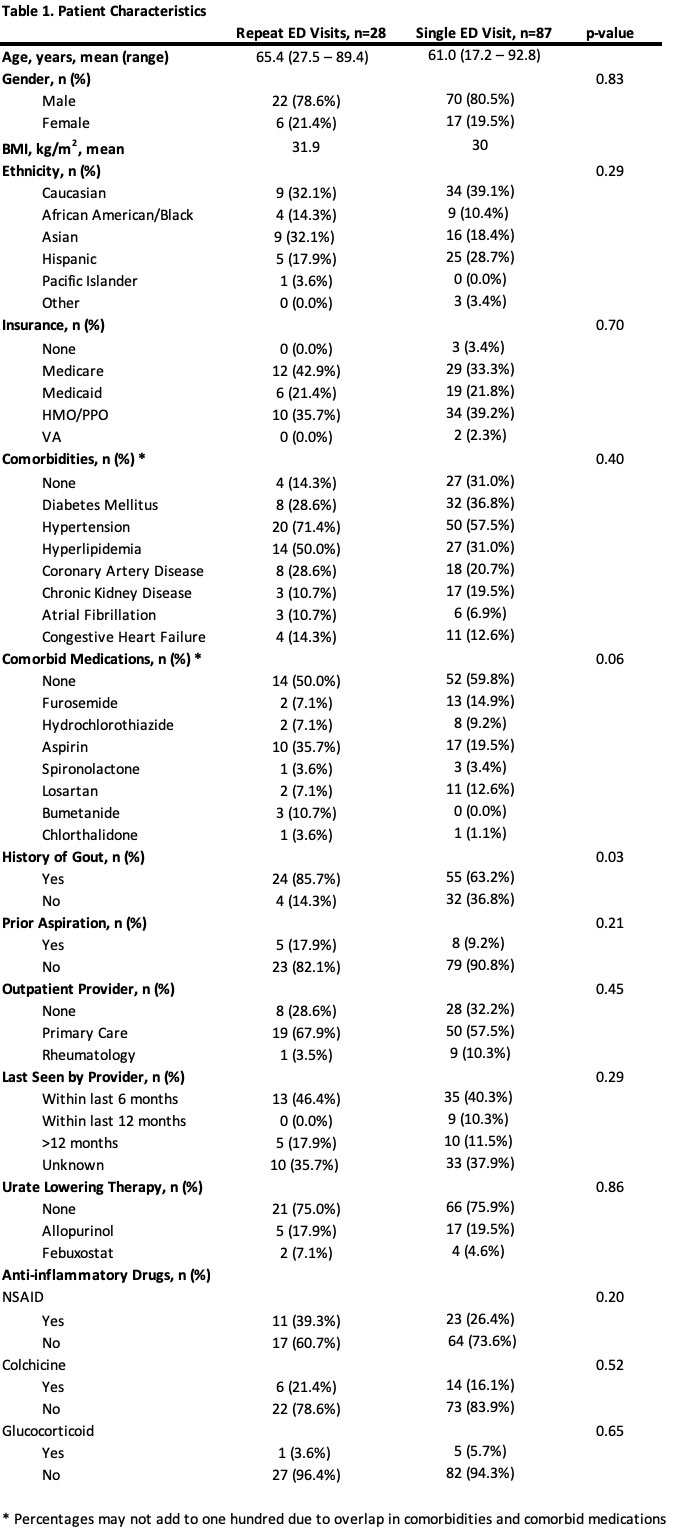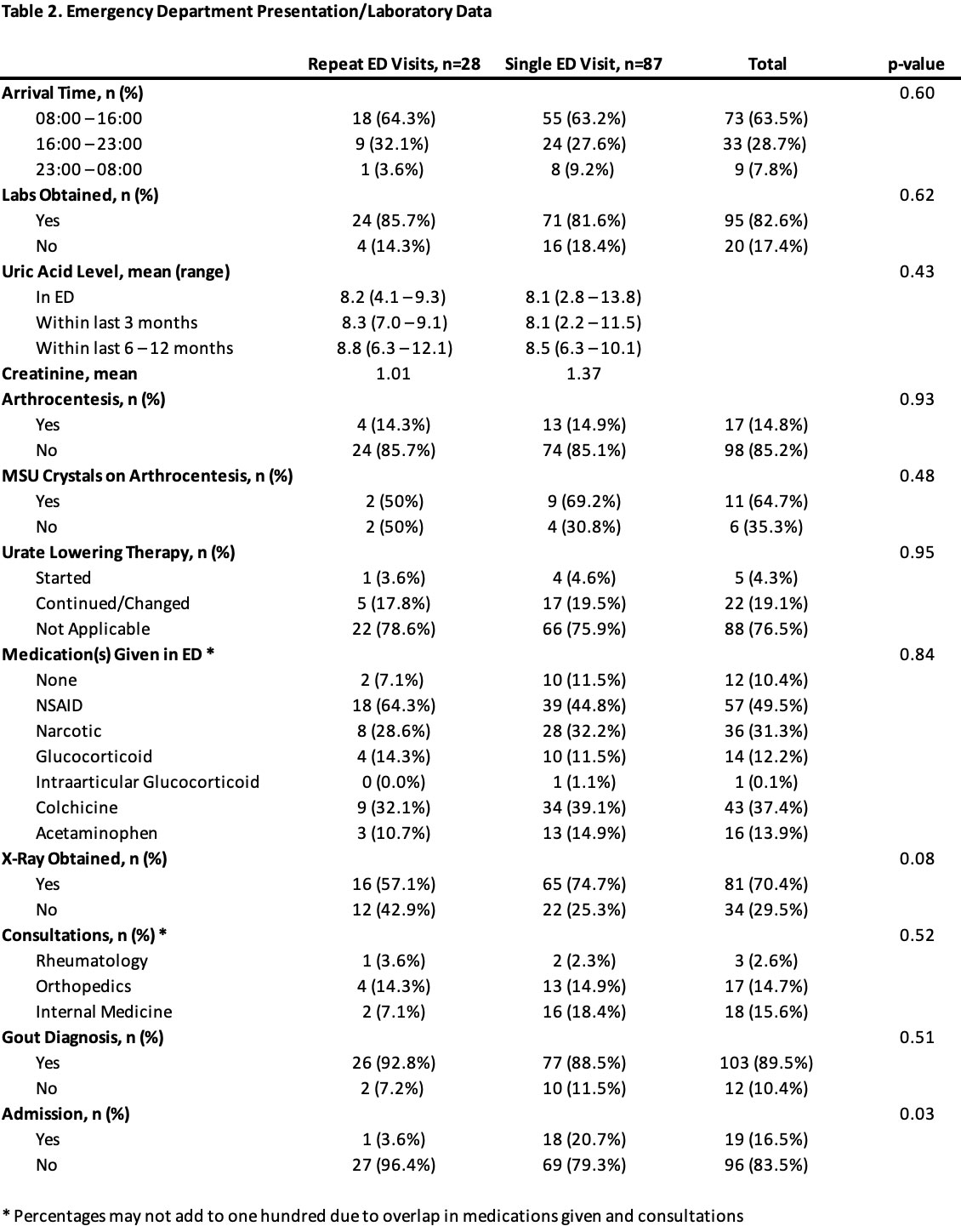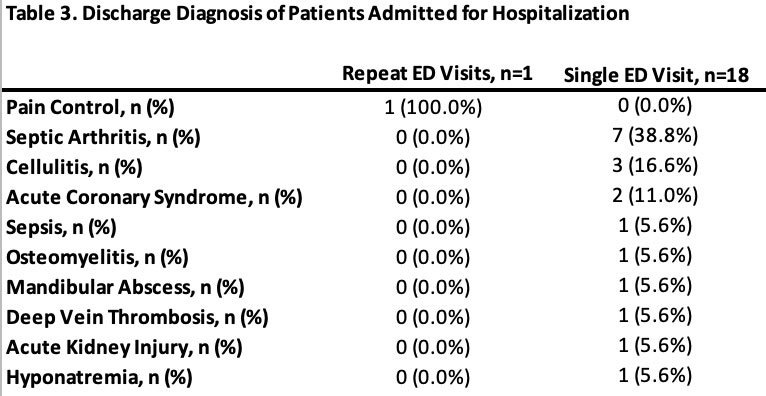Session Information
Date: Monday, November 14, 2022
Title: Metabolic and Crystal Arthropathies – Basic and Clinical Science Poster
Session Type: Poster Session D
Session Time: 1:00PM-3:00PM
Background/Purpose: Gout is the most common inflammatory arthritis in adults that results in high disease burden and health care utilization. The objective of the study is to describe factors seen in patients with repeat Emergency Department (ED) visits at a university hospital to elucidate barriers in gout care and improve health care utilization.
Methods: A retrospective chart review of adult patients seen at a university hospital ED with a discharge diagnosis of gout from 1/1/2019 to 12/31/2020 was performed. Patient demographics, comorbidities, outpatient drugs, diagnostic and therapeutic interventions performed at the ED were noted. The admitting diagnoses of patients who required hospitalization were evaluated. Descriptive statistics and Pearson’s chi-square test were performed between those that had repeat ED visits and those with a single ED visit.
Results: A total of 115 patients were included: 28 patients (24.3%) had repeat ED visits, while 87 patients (75.7%) had a single visit (Table 1). Most patients were elderly, male, obese, and did not have prior intake of urate lowering therapy (ULT) and/or anti-inflammatory drugs (AID). A higher proportion of Asian patients returned to the ED, while Hispanics were less likely to return. Patients with Medicare insurance and comorbidities, including hypertension (71.4%) and hyperlipidemia (50%) were more often seen in the ED return group. Most patients with repeat ED visits already had a documented history of clinically diagnosed gout, with most having no history of prior aspiration for crystal diagnosis. Outpatient management by primary care physician and not having an outpatient visit within the preceding 12 months was more common in those with repeat ED visits.
Time of ED presentation was similar between the two groups, as was getting labs obtained (Table 2). Outpatient uric acid levels were similarly not at goal. Those that returned to the ED had a mean creatinine that was within normal limits, while those with a single ED visit had a higher average creatinine. Overall, arthrocentesis was seldom performed at the ED (14.8%), and when performed, urate crystals were identified 64.7% of the time. ULT management in the ED and use of consultation services were similarly low. Only 4.3% of the total patients were started on ULT at the ED. Most were given a NSAID for pain.
Hospitalizations were highest in the group with a single ED visit (20.7%) while only 1 patient was admitted in the group with repeat ED visits. Among those that had an inpatient admission, most were for reasons other than acute gout (Table 3).
Conclusion: Our findings show that certain factors are seen more frequently in patients with repeat ED visits for gout. Asian ethnicity, the presence of comorbidities, and not having outpatient follow up were more frequently seen in those with repeat ED visits. While arthrocentesis is the gold standard for gout diagnosis, this is rarely performed. There was less ED return in patients who had an inpatient admission, although a majority of admitting diagnoses were for reasons other than acute gout. Further studies analyzing characteristics of gout patients associated with recurrent ED visits and hospitalizations are needed to improve outcomes.
To cite this abstract in AMA style:
Lim D, Aggarwal M, Cabling M. Characteristics of Patients with Repeat Visits for Acute Gout at a University Hospital Emergency Department [abstract]. Arthritis Rheumatol. 2022; 74 (suppl 9). https://acrabstracts.org/abstract/characteristics-of-patients-with-repeat-visits-for-acute-gout-at-a-university-hospital-emergency-department/. Accessed .« Back to ACR Convergence 2022
ACR Meeting Abstracts - https://acrabstracts.org/abstract/characteristics-of-patients-with-repeat-visits-for-acute-gout-at-a-university-hospital-emergency-department/



